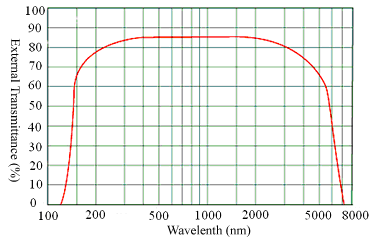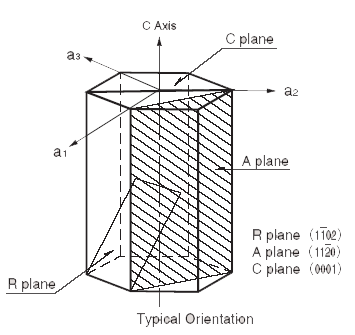|
Sapphire has a unique combination of physical, chemical and optical properties, which make it resistant to high temperature, thermal shock, water and sand erosion, and scratching. It is a superior IR window material for use under such conditions as high temperature and pressure, thermal shock, corrosion resistance, abrasion resistance or chemical attack. Sapphire exhibits high internal transmittance all the way from 150nm to 6um. It is very hard, second only to diamond. Large sizes are grown by using the heat exchanger method (HEM). Sapphire has a hexagonal crystalline structure and exhibits birefringence, a difference of 0.008 (refractive index of e-ray is smaller, negative uniaxial crystal). Besides optical applications, C-plane sapphire substrates are widely used to grow III-V and II-VI compounds such as GaN for blue LED and laser diodes, while R-plane sapphire substrates are used for the hetero-epitaxial deposition of silicon for microelectronic IC applications.
| |
 |
| |
Figure 1: Refractive index verse wavelength for O-ray
|
| |
 |
| |
Figure 2: 1-mm thick sapphire external transmittance curve
|
| |
 |
| |
Figure 3: Sapphire Unit Cell
|
| |
Coefficient of Linear Thermal Expansion
40~400 °C (/°C) |
Parallel to C Axis 7.7X10-6
Perpendicular to C Axis 7.0X10-6 |
|
| |
Thermal Conductivity (40°C W/m·K) |
25.12
|
|
| |
Melting Point (°C) |
2053
|
|
| |
Specific Heat (J/(Kg·K) |
0.75X103
|
|
| |
Density (g/cm3) |
3.99 |
|
| |
Young's Modulus (GPa) |
345
|
|
| |
Poisson's Ratio |
0.18~0.29 (Orientation Dependent)
|
|
| |
Shear Modulus (GPa) |
146
|
|
| |
Mohs Hardness |
9
|
|
| |
Structure
|
Hexagonal-rhombohedral
|
|
| |
Lattice Constants (Å) |
a=4.763 c=13.003 |
|
| |
Dielectric Strength (V/m)
|
48X106
|
|
| |
Dielectric Constant
|
Parallel to C Axis 11.5 (1MHz)
Perpendicular to C Axis 9.3 (1MHz) |
|
| |
Volume Resistance (Ω·cm, 20°C) |
>1014 |
|
| |
Table 1:Sapphire Thermal and Mechanical Properties
|
|
IR Materials :
|





